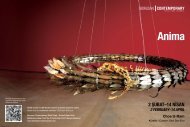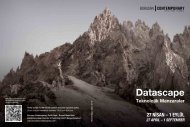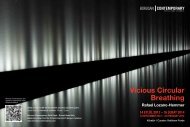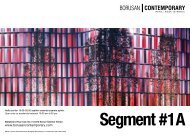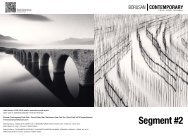Segment #3 Sergisi'nin broÅürü için tıklayınız. - Borusan Contemporary
Segment #3 Sergisi'nin broÅürü için tıklayınız. - Borusan Contemporary
Segment #3 Sergisi'nin broÅürü için tıklayınız. - Borusan Contemporary
You also want an ePaper? Increase the reach of your titles
YUMPU automatically turns print PDFs into web optimized ePapers that Google loves.
Bengü Karaduman Spot On #5<br />
THE PLANETS ARE ATTACHED TO THIS TREE WITH A THREAD<br />
Bengü Karaduman, known for her interdisciplinary projects in the contemporary art scene in İstanbul,<br />
is the youngest artists ever represented in the SPOT ON exhibition series which focus on artists in the<br />
<strong>Borusan</strong> <strong>Contemporary</strong> collection. Previous SPOT ON artists were eminent figures of the international<br />
contemporary art world such as Manfred Mohr, Ola Kolehmainen, Sol LeWitt and François Morellet,<br />
and this is the first time works of a Turkish artist will be exhibited as part of the SPOT ON series on the<br />
third and fourth floor of <strong>Borusan</strong> <strong>Contemporary</strong>.<br />
Karaduman’s project titled “The Planets Are Attached To This Tree With A Thread” could be considered,<br />
in whole, as a site-specific installation comprising as diverse techniques as video, animation,<br />
performance, sculpture, drawing and collage. The artist aims to divert the viewer’s attention away<br />
from causality and have them focus on the sky, stars and messages from other worlds by embarking<br />
on different visual experiments to ensure this “change of perception”. Her works in the <strong>Borusan</strong><br />
<strong>Contemporary</strong> Collection and those realized for this exhibition brought together, they point at the<br />
condition of today’s human beings who are in a constant search for “standpoint” for themselves.<br />
The variety of visual forms Karaduman has employed ever since attains a level enveloping the viewer<br />
in themselves with direct interventions to the space in this exhibition. The artist has turned the<br />
exhibition space, the third and fourth floors of Perili Köşk, into a something that can be conceived as<br />
a whole because she does see architecture as merely a “shell”. Together with the physical presence<br />
of the <strong>Borusan</strong> employees spending an important part of their daily lives in Perili Köşk, she manages<br />
to create a project focusing on the “wish for freedom”.<br />
Even though technological progress is overshadowed by the elements that facilitate the lives of human<br />
beings, it manages to makes us ponder on the significance of the modern individual’s questions<br />
“Whom have I become, Where have I found myself, Where am I going”. In search for answers to<br />
these eminent questions, Karaduman takes the uneasiness created by these times we are living in<br />
on our bodies and our souls as a starting point. She irrationally but intentionally uses the tree of life<br />
concept attributed to the shamans to present the images of other planets and imaginary worlds to<br />
the viewer. Karaduman’s approach to shaman philosophy and mythology also bears importance in<br />
respect of the conceptual approach and performance techniques she has specially developed for this<br />
exhibition, because the shamanic figures in the exhibition assume the function of uttering modern<br />
individuals’ inner messages and screams in addition to their usual duties of healing the sick and<br />
making wishes come true.<br />
The video Works “Day Pole” and “Night Pole” which are the backbone of the exhibition starts with<br />
the elevator which operates between the third and fourth floors of Perili Köşk. When the doors of the<br />
elevator open, shamans with different costumes appear with dances and rituals and then disappear.<br />
Karaduman’s animation which is realized by using video techniques and which shows these shamans<br />
and their world, functions like a combining element for all the works in the exhibition. When she puts<br />
these shamans on the stage as a protest against the technology’s effect of reducing the individual’s<br />
relationship with nature to a minimum, she succeeds in bringing about the most unexpected, most<br />
innocent and the innermost to the foreground. Representing an animist approach to life, the shamans<br />
ensure an “energy flow” by summoning the strength to overcome hardships by supernatural powers<br />
they have collected from the sky and the stars. Karaduman’s work presents the individual’s wish to be<br />
free and himself/herself in the form of images using visual codes and metaphors.<br />
Karaduman’s images in the exhibition use “dual elements”. Many of the motifs in the exhibition are<br />
repeated with black-white contrasts and the opposing concepts of upper-lower, full-empty turn into<br />
leitmotifs in the hands of the artist. As the shamans in the video projections are also used in the other<br />
visual elements of the exhibition by way of association, the viewer is presented with quite a different<br />
model of reading. When Karaduman presentes the location of the celestial objects on the northern<br />
and southern hempisheres using symbols, signs and maps and adds the costumes she designed<br />
for the shamans to the exhibition, she provides clues as to what is real and what is fiction. Some of<br />
the objects attached to these costumes for luck and good fortune are contributed by the <strong>Borusan</strong><br />
employees.<br />
Karaduman’s exhibition “The Planets Are Attached To This Tree With A Thread” reminds the viewer<br />
that a “real life” which may succeeded in establishing a direct relationship with nature is possible.<br />
9



